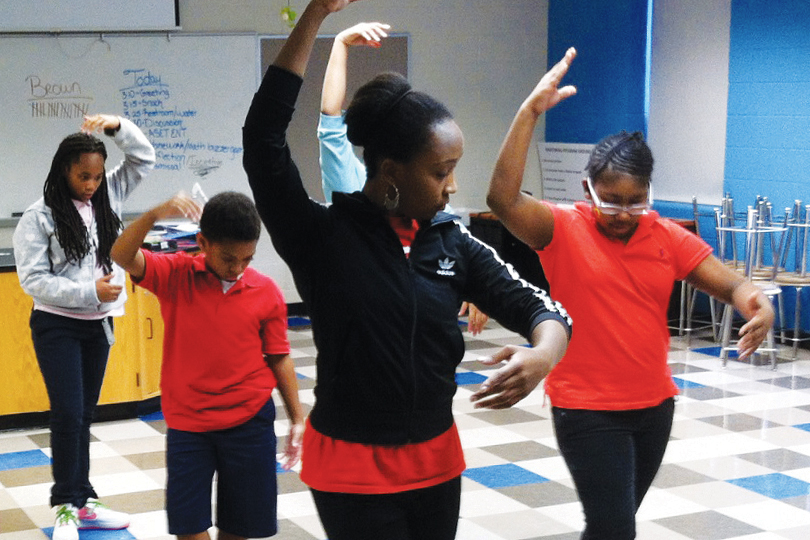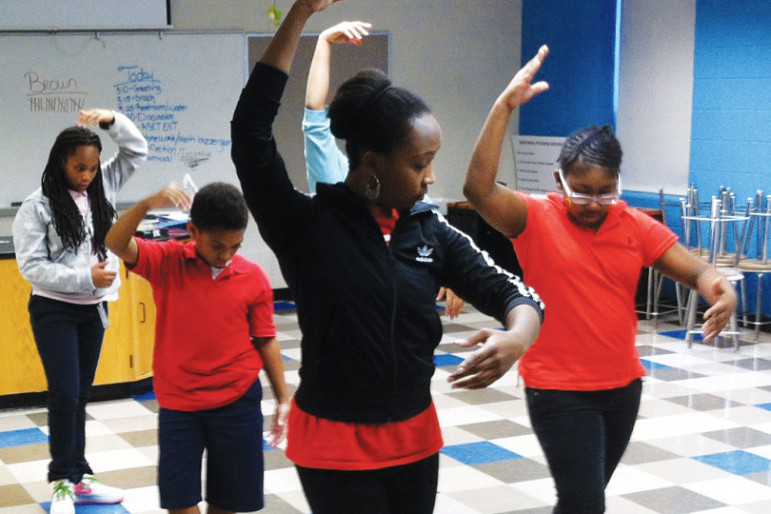
Sandra Harris
Students at a PENCIL PACE site learn a dance routine with an instructor from ASET Academy for the Performing Arts.
One morning in January, 80 teachers, principals and after-school staffers gathered in a large conference room at the Nashville Public Library to do something once unthinkable: They shared data about kids they work with and talked about how to use it.
The city’s public schools and a network of out-of-school time (OST) providers routinely trade information on nearly 1,000 of Nashville’s neediest youth, including grades, disciplinary referrals, after-school participation and developmental assets. They figure the more they know about these young people, the better they can identify needs and customize supports like tutoring, mentoring and family services.
Sharing data is not the only development in Nashville, where the network of OST providers (the Nashville After Zone Alliance) works with schools on staff training and program design. That kind of collaboration is growing in communities around the country, as the relationship between the OST and education fields grows stronger.
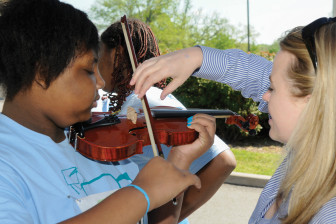
Metro Photography Services
The Nashville Symphony’s “instrument petting zoo” provides NAZA students an opportunity to learn about orchestra instruments.
“We’re taking each other more seriously — and trying to figure out what it means to go deeper,” said Hillary Salmons, executive director of the Providence After School Alliance (PASA).
The OST field has long pursued a deeper relationship with schools, but most schools have just wanted to be friends. Changes on both sides have pushed them closer.
Educators are under increasing pressure to better prepare students for college and careers by building critical life skills that go beyond strict academics. These skills are learned not from books, but through the interpersonal activities in which OST specializes — “the sweet spot,” as Salmons calls it.
The OST field, meanwhile, “has really matured,” said Priscilla Little, who oversees the Wallace Foundation’s initiative to increase afterschool quality. That maturity shows through the development of better quality standards, staff training and outcome measures, as well as the growth of community and statewide OST systems.
As a result, “we’re seeing more systemic changes” involving entire school districts and provider networks, as opposed to a smattering of programs that partner with individual schools, said Jessica Donner, director of Every Hour Counts, a New York-based national coalition of school/afterschool partnerships.
To be sure, the relationship is still evolving; it is a story of progress tempered by qualifications. The changes are uneven across the country, and rarely as extensive as OST advocates hope for. New movements pose new challenges. And the deepening relationship makes more critical the question of whether OST providers will bend their services to accommodate the needs of schools at the expense of their core mission — which, as the very name of the field says, is not school.
Early partnership efforts
Many OST providers have long seen partnerships with schools as crucial to their scale and sustainability. This is especially so for those that serve needy kids whose families are unlikely to write big checks for camps and sports programs. In 1998, Youth Today’s front page examined that effort in a story headlined “Youth Agencies Clamor to Stay After School.” Building such relationships has been a key strategy in the millions of dollars in grants spent by the Wallace and Mott Foundations to improve after-school quality and build networks.
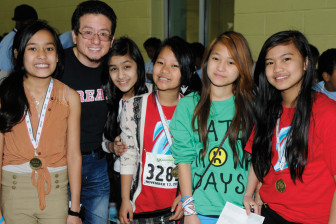
Metro Photography Services
A group of students and their teacher celebrate their completion of the 5K Fun Run at NAZA’s annual showcase.
For a long time, the partnerships consisted basically of schools providing space for after-school programs or transportation to program sites. OST programs remained more guest than partner: Many an arrangement was upended by a change in school leadership, priorities or budget. Providers “needed to become skilled in … navigating relationships and turf issues with school personnel and administrations,” wrote Ellen Gannett, director of the National Institute on Out-of-School Time (NIOST), in the Spring 2012 journal “Research & Action Report.” OST managers quipped that the key to success with schools was not irritating the janitor.
That began to change with the creation of the federal 21st Century Community Learning Centers program in the 1990s. Through the CLC (as it is popularly known), states allocate federal funds for after-school activities (particularly in high-poverty, lowperforming schools). The law encourages collaboration between schools and community-based organizations (CBOs).
“Schools had to take youth organizations seriously,” said Jane Quinn, director of National Center for Community Schools, run by the Children’s Aid Society.
Though not right away. The CLC grants initially went only to schools, many of which ran the after-school programs with their own staff and defined “partnership” as paying an OST program for a la carte services, like sending over a dance instructor once per week. A U.S. Department of Education evaluation of the CLC (“When Schools Stay Open Late,” Mathematica Policy Research, 2003) found that “collaborations in the sense of shared governance and integrated operations were rare.”
Many schools “didn’t really understand or appreciate what OST providers could bring to the table,” recalled Sam Piha, a former teacher and after-school worker who founded a consulting group, Temescal Associates, for education and youth-development organizations. “At the same time, many OST providers knew little about launching programs on school sites. This led to a great deal of confusion and tension.”
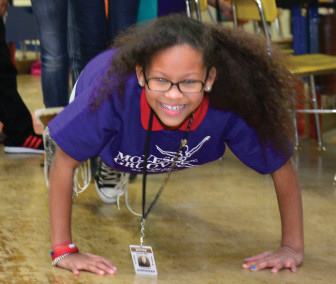
Metro Photography Services
Relay races provide a fun fitness activity after school for students in Moves & Grooves at Apollo Middle School.
More and more, schools and OST providers learned to mold their efforts for a better fit. Today the CLC stands as the largest federal funding stream dedicated to after-school programs, rising from $40 million in 1998 to $1.1 billion in 2014. Gina Warner, executive director of the National AfterSchool Association, calls it “a game changer in the scalability of afterschool.”
But still, the growth of CLC brought to the fore the tension that underlies many school-based after-school programs: How much should the program serve academic needs? School administrators saw CLC as a way to help raise test scores. Many OST providers obliged, building in academic help (like tutoring) and modifying their fun stuff to align with classroom work through book clubs, math-based games and hands-on science (such as gardening).
Thus OST advocates like Gannett ponder, “Is it only in the service of the schools that OST exists?” The question was answered most bluntly by Robert Halpern of the Erikson Institute, in a 2006 paper entitled, “Confronting the Big Lie.” He urged after-school programs to stop trying to prove they can raise academic achievement and to focus instead on their impact on child and youth development.
It is still routine for funders (especially government) to ask OST providers for evidence of academic impact. In recent years, however, the pendulum of the school/OST partnership has ticked back a bit toward youth development — largely because of forces in education.
Learning reforms spark change
STEM. Soft Skills. Expanded Learning. These buzzwords describe a mix of learning concepts and strategies that relate to each other and sometimes overlap. All are grounded in the belief that the hard-core, teach-and-drill-tothe- test movement in U.S. classrooms has produced inadequate results in academic achievement and workforce readiness. Each seeks to redefine what kids learn, along with where, when and how, and who teaches them — often in ways that play to the strengths of OST.
“The nature of education is changing,” said Gwynn Hughes, program officer at the Mott Foundation. “What kids need has changed. They need to develop all the 21st century skills like critical thinking and problem-solving” in order to succeed in college and career.
That, she said, leaves OST providers better positioned “to provide the kind of programs that help schools meet the needs of kids.”
Take STEM education, which seeks to improve the teaching of science, technology, engineering and math. Seems like an assignment to stick your nose in a book. But no: STEM education stresses thinking, not just memorization of formulas and facts. “STEM skills are defined as not just showing that a student got a better math score, but that he can do problemsolving,” said Karen Pittman, CEO of the Forum for Youth Investment. STEM education rewards inquisitiveness, creativity and working through a hypothesis.
[module type=”aside” align=”right”]Resources
Resources for programs that want to increase their youth-development outcomes by linking to the schools or vice versa, apply their after-school learning efforts to reinforce what happens at school:
- Afterschool Alliance – afterschoolalliance.org
- National AfterSchool Assocation – naaweb.org
- National Institute on Out of School Time – niost.org
- “Better Together: Building Local Systems to Improve Afterschool” by the Wallace Foundation
- “Is Citywide Afterschool Coordination Going Nationwide” by the Wallace Foundation
On the seemingly opposite side of the learning continuum are competencies that kids need but also can’t master by memorization. These are generally known as soft skills, but also as “21st century,” “social/emotional” and “non-cognitive” skills. (They are largely the same with some distinctions, depending on who compiles the list.) They include such skills as communication, conflict resolution, planning, critical thinking and teamwork.
Business leaders have been pushing for better development of these skills, telling schools that students are coming to the workforce unprepared to do what these skills require.
The trouble for schools: Both the STEM and soft skills movements call for learning things that are different from what schools focus on, and that are taught in ways that differ from what schools typically do. They require project- based learning, experiential learning and relationship-building, all pursued in a playful environment unhindered by the demands of a mandated curriculum.
For OST, “that’s the sweet spot,” said Little of the Wallace Foundation. “That’s what these programs have been set up to do.” And they do it in a way that’s more engaging than what typically goes on when students sit at desks.
More and more, OST activities that once seemed like fuzzy extras have real value for educators. “We’ve all realized that in moving forward to build the 21st century skills like critical thinking, collaboration … that kids need a different experience than you have in the traditional classroom,” said Randy Poe, superintendent of Boone County (Ky.) Public Schools. “The schools can’t do this by themselves.”
To meet the demands, more principals and superintendents are turning to OST providers. “We’ve realized if it’s not our core business let’s partner with somebody for whom it is their core business,” said Todd F. Hoadley, superintendent of Dublin City Schools in Ohio.
For example: The Boone County schools used to run a summer reading program. Now the program is carried out by the local library system in coordination with schools. “We never tapped into that” before, Poe said.
Networks grow
As more schools turn to OST to help answer these expanding challenges, they see a field that’s matured significantly in the past 10 to 15 years.
One sign of that maturity is the growth of OST systems with cities and states. These networks coordinate services and/or serve as intermediaries between providers and the local school systems, as well as other government entities.
These system-to-system relationships — such as PASA working with the Providence Public School District — alleviate a headache for school administrators, who used to face dozens of providers pitching services each year. Now school districts can access many services while dealing primarily with one entity, while providers can deal more easily with entire districts rather than individual schools.
“It’s a lot easier for principals to say, ‘You’ve got the infrastructure to serve 300 out of my 700 kids, and I don’t have to deal with 12 executive directors,’” said Salmons, at PASA.
In a 2013 study, “Is Citywide Afterschool Coordination Going Nationwide?,” Wallace identified 77 cities that had “some” or a “highly coordinated approach” to after-school programming. Still, noted Wallace’s Senior Program Officer Dara Rose, such coordination “is still not the norm.”
Quality rises
Along with (and often because of) the networks, more programs have instituted research-based standards, assessments and staff training — which raises the confidence of school officials in the quality of their services. In some places, such as New York, Nashville and Providence, school and OST staff join each other’s professional-development training, which increases their understanding of each other’s work and strengthens their ability to align their efforts.
For schools, the prime measure of a program’s value is its effect on students’ grades. While programs have improved their ability to show academic gains among participants, that’s not the yardstick that most OST providers prefer. Armed with a small but expanding set of measurement tools, some providers are shifting the focus to how they improve behaviors that link to school success.
For example, studies in several cities (e.g., Los Angeles, Baltimore and New York) show that regular attendance at high-quality after-school programs boosts attendance in school – an important impact at a time when schools are pushing to increase attendance as part of a larger effort to raise graduation rates. Some high-quality after-school programs have also been shown to boost homework completion and parental engagement in children’s lives, and to reduce behavioral problems in school and risky behaviors, like drug use, that undercut their studies. (See Outcomes Box.)
“We are playing with a very strong suit here,” Salmon said, “because we’re getting increasing evidence about the results of children’s participation in high-quality OST programs.”
Still, the discussions about what is measured in OST, and how to measure it, continue to evolve. “We’re just in the beginning stages of how we can measure progress,” said NIOST’s Gannett.
New challenges and opportunities
Meanwhile, two current movements in education present another challenge for OST providers who work with schools.
One is Expanded Learning — a phrase often followed by “Time” or “Opportunities,” reflecting a debate over what gets expanded. Educators tend to talk about expanding time — stretching the school day or year to fit in more instruction. A 2011 report by Education Sector, a Washington-based nonprofit think tank focused on education policy, found that thousands of public schools had recently expanded the day or year, or planned to.
Non-school providers stress expanding opportunities by stretching not only time, but also what students learn, and how. For example: The ExpandED initiative, developed by The After-School Corporation and piloted in 11 schools in New York, Baltimore and New Orleans, expands the school day by at least 35 percent but requires strong collaboration between schools and community partners to determine what occurs during that time.
An evaluation by Policy Studies Associates, released in April, found mixed results: Some sites showed “progress toward shared responsibility for learning” among educators and communitybased organizations, while at other sites, “establishing a true partnership that promotes a seamless expanded school day is an ongoing process.”
In many places, however, expanded learning is an academic-dominated endeavor, with OST providers brought in as needed for occasional fun activities. Pittman (at the Forum for Youth Investment) sees danger: If expanded learning becomes little more than expanded class time, she said, “we will undermine more than a decade of work to strengthen OST learning opportunities in alignment with schools.”
A similar challenge is presented by the Common Core State Standards — adopted by states to define what students should know in math and English at each grade level. Organizations that advocate for afterschool and enrichment activities (such as the Arts Education Partnership) have been churning out advice, tools and training to help OST providers create activities that support these academic goals. States are just beginning to implement the standards, and in some schools that implementation includes collaboration with OST providers. The Massachusetts Afterschool Partnership, for example, co-developed the state’s Creative Minds arts curriculum to align with the Common Core.
Are schools receptive?
So, the “how do we partner with schools but not look like school” challenge persists as inherent in the relationship. The question to keep in mind, said Gannett: “What is the unique contribution that OST brings to this partnership? It’s not just doing what schools do differently.”
Despite the deepening of the relationship in many places, progress is driven largely by what schools need. What if the next education reform dismisses soft skills with a “pffff ”?
Which is why Hughes of the Mott Foundation said, “We’re on the right track” in developing a substantive and stable relationship. “We need to do more.”
Patrick Boyle, former editor of Youth Today, is communications director at the Forum for Youth Investment.


